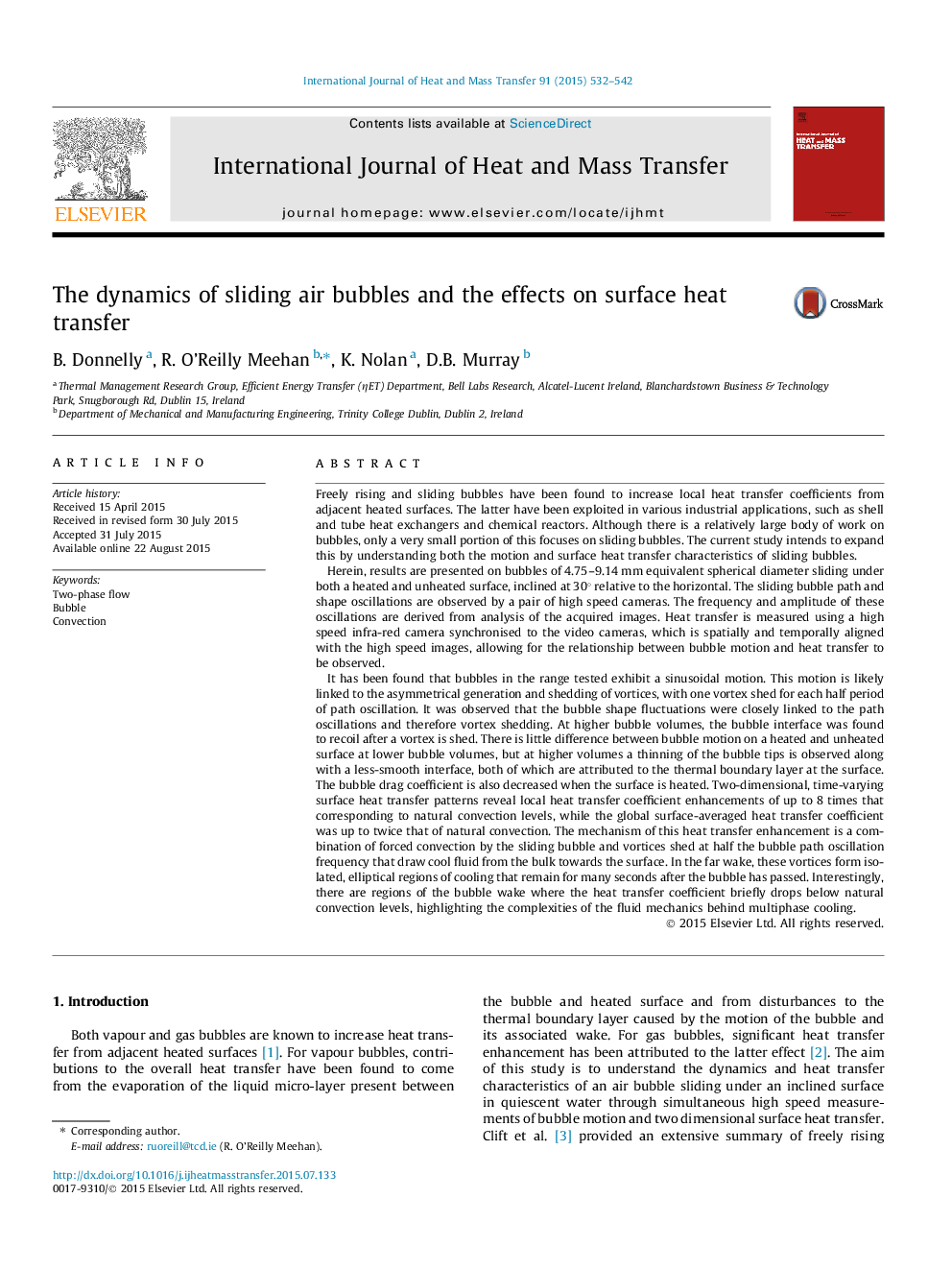| کد مقاله | کد نشریه | سال انتشار | مقاله انگلیسی | نسخه تمام متن |
|---|---|---|---|---|
| 7056258 | 1458051 | 2015 | 11 صفحه PDF | دانلود رایگان |
عنوان انگلیسی مقاله ISI
The dynamics of sliding air bubbles and the effects on surface heat transfer
ترجمه فارسی عنوان
پویایی حباب های کشویی هوا و اثرات انتقال حرارت بر روی سطح
دانلود مقاله + سفارش ترجمه
دانلود مقاله ISI انگلیسی
رایگان برای ایرانیان
کلمات کلیدی
جریان دو مرحله ای، حباب، همرفت،
ترجمه چکیده
یافته شده است که حباب ها در محدوده آزمایش شده، یک حرکت سینوسی دارند. این حرکت به احتمال زیاد با نسل نامتقارن و ریختن گردابه ها مرتبط است، و یک گرداب برای هر نیم دوره نوسان در مسیر رها شده است. مشاهده شد که نوسانات شکل حباب به شدت با نوسانات مسیر مرتبط بود و بنابراین انحراف گرداب. در حباب های بالاتر، رابط گرافیکی حباب بعد از گرد و غبار رها شد. تفاوت بین حرکت حبابی در سطح گرم و غیر گرم در حجم حباب کمتر، تفاوت کمی وجود دارد، اما در حجم های بالاتر، نازک شدن نقاط حباب همراه با یک رابط کوچکتر، که هر دو به لایه مرزی حرارتی در سطح ضریب کشیدن حباب نیز هنگامی که سطح گرم می شود، کاهش می یابد. الگوهای انتقال حرارت دو بعدی، زمان متغیر، ضریب انتقال حرارت محلی را تا 8 برابر بیشتر از سطح کنسانتره طبیعی نشان می دهند، در حالی که ضریب انتقال حرارت به طور میانگین در سطح جهانی تا دو برابر بیشتر از انتقال حرارت طبیعی است. مکانیسم افزایش این انتقال حرارت، ترکیبی از جابجایی اجباری توسط حباب کشویی و گردابها است که در نیمی از فرکانس نوسان مسیر حباب ریخته می شود که مایع خنک را از حجم به سطح می رساند. پس از پیروی از این، این گردابها از مناطق خنثی و بیضوی خنثی تشکیل شده اند که به مدت چند ثانیه پس از گذراندن حباب باقی می مانند. جالب توجه است، مناطقی از حبابی که در آن ضریب انتقال حرارت به طور خلاصه کاهش می یابد در زیر سطح رسوبات طبیعی وجود دارد، برجسته پیچیدگی مکانیک سیالات پشت خنک کننده چند مرحله.
موضوعات مرتبط
مهندسی و علوم پایه
مهندسی شیمی
جریان سیال و فرایندهای انتقال
چکیده انگلیسی
It has been found that bubbles in the range tested exhibit a sinusoidal motion. This motion is likely linked to the asymmetrical generation and shedding of vortices, with one vortex shed for each half period of path oscillation. It was observed that the bubble shape fluctuations were closely linked to the path oscillations and therefore vortex shedding. At higher bubble volumes, the bubble interface was found to recoil after a vortex is shed. There is little difference between bubble motion on a heated and unheated surface at lower bubble volumes, but at higher volumes a thinning of the bubble tips is observed along with a less-smooth interface, both of which are attributed to the thermal boundary layer at the surface. The bubble drag coefficient is also decreased when the surface is heated. Two-dimensional, time-varying surface heat transfer patterns reveal local heat transfer coefficient enhancements of up to 8 times that corresponding to natural convection levels, while the global surface-averaged heat transfer coefficient was up to twice that of natural convection. The mechanism of this heat transfer enhancement is a combination of forced convection by the sliding bubble and vortices shed at half the bubble path oscillation frequency that draw cool fluid from the bulk towards the surface. In the far wake, these vortices form isolated, elliptical regions of cooling that remain for many seconds after the bubble has passed. Interestingly, there are regions of the bubble wake where the heat transfer coefficient briefly drops below natural convection levels, highlighting the complexities of the fluid mechanics behind multiphase cooling.
ناشر
Database: Elsevier - ScienceDirect (ساینس دایرکت)
Journal: International Journal of Heat and Mass Transfer - Volume 91, December 2015, Pages 532-542
Journal: International Journal of Heat and Mass Transfer - Volume 91, December 2015, Pages 532-542
نویسندگان
B. Donnelly, R. O'Reilly Meehan, K. Nolan, D.B. Murray,
